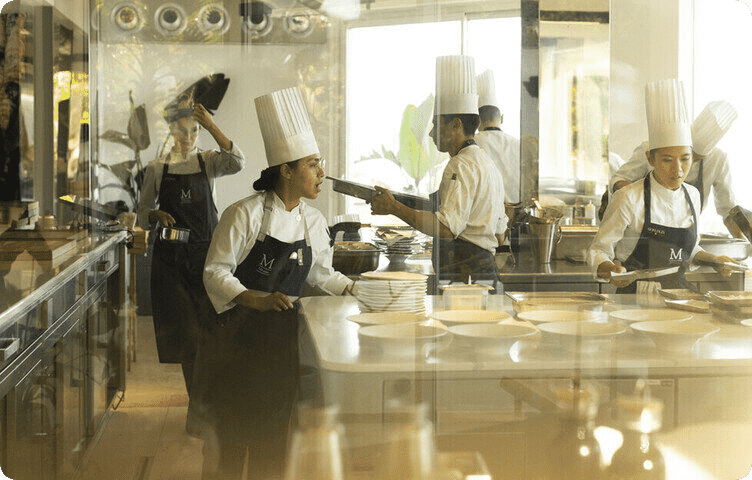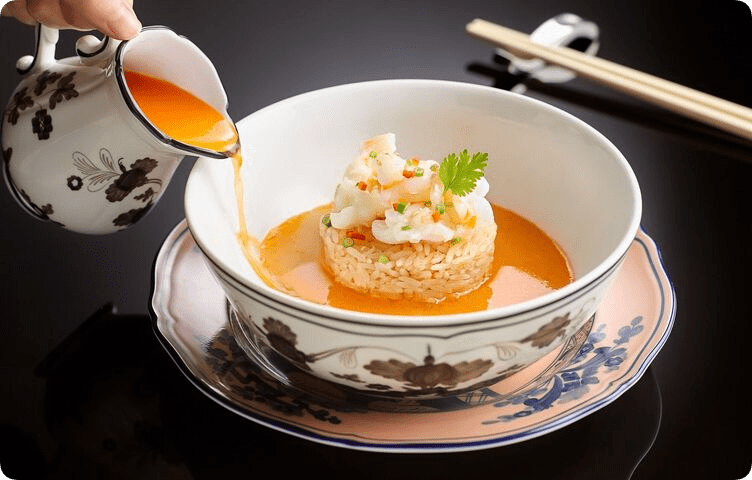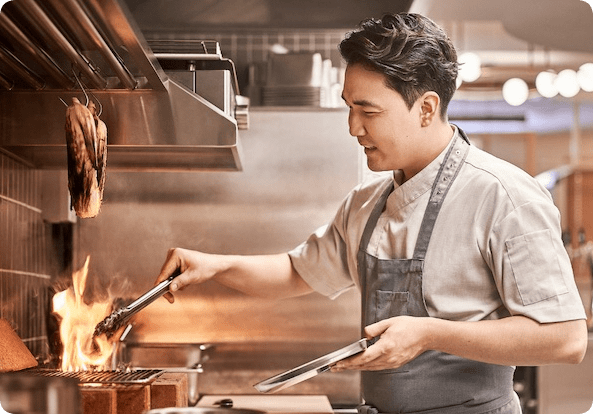In January this year, the Michelin Guide asked Asian star chefs and restaurant owners to look into a crystal ball and try to predict what 2023 will be like for the restaurant industry. In this article, we share with you a brief retelling of the main trends and trends in the restaurant industry from the famous guide!
1. International and intercultural cooperation is gaining new momentum
The restaurant industry is a global, socially engaged community, and the three-year break from in-person gatherings has created a huge appetite for human interaction. Now that travel restrictions across Asia have eased, international events featuring guest chefs, shared dinners, menu swaps and all sorts of global collaborations are expected to return in 2023, say the region's chefs.
Chef Xu Jingye of 102 House Restaurant in Shanghai is looking forward to the return of international exchanges: “As China gradually opens up, chefs will travel to other countries for inspiration and will have more opportunities to interact with local chefs, which will create new sparks in cooking."
According to chef Pichai "Pam" Soonthornanakij of one-star restaurant Potong in Bangkok, these exchanges will pave the way for more cross-cultural cuisine in 2023. “You'll start to see Thai-Spanish tapas, Japanese-Italian food and more. I truly believe that food brings people together in a fun and delicious way!”

2. More restaurants will turn to technology to solve the global restaurant staffing shortage.
Many chefs predict the labor shortages plaguing restaurants around the world will continue into 2023 and even worsen as full-service restaurant dining returns in full force once COVID-19 regulations are eased.
“The nature of the restaurant industry today is one of intensive daily work and long working hours at the expense of employees' personal time, all of which make it difficult to attract talent,” said Wu Zhi-Wei, executive chef of the one-star MICHELIN-star Shin Yeh Taiwanese Signature Restaurant. He adds that many classic Chinese dishes, which are hand-cooked and take time to master, could disappear if labor shortages continue.
Turning to technologies such as QR menus, dark kitchens and various apps is in line with changing consumer preferences, says Pam, chef at Potong. As digitally savvy Gen Zers and Millennials seek fresh food, mobile ordering and automated vending machines that have become commonplace in their daily lives, fine dining restaurants must begin using more digital tools to enhance their patrons' experiences.

3. Back to basics: classics are back in fashion
In the fast-paced modern world, people are increasingly turning to traditional comfort foods.
Diners are looking for restaurants that use locally sourced ingredients, prepare dishes using traditional methods, flavor them with local seasonings and even serve them in traditional dishes. “Local ingredients, cooking methods and cultural expressions are unique and irreplaceable. When we strive to present authentic flavors in a way that allows more visitors to appreciate and connect with local culture and nature, that is meaningful globalization,” says Zhou Ziling, owner of the one-Michelin-star Silver Pot restaurant in Chengdu.
At the same time, Labyrinth chef Khan believes that the appeal of rustic cooking methods will increase significantly. “Cooking with wood will remain fashionable. This style of cooking has dominated the industry for the past two years, and we now see it in cuisines ranging from Italian to Spanish, Indian and Filipino. In 2023, we will have grilling and wood grilling concepts that will become more accessible to the mass market,” he predicts.
Daniel Calvert of the two-star Sézanne restaurant in Tokyo expects diners to return to smaller restaurants where the emphasis is on fresh, ingredient-driven dishes, often with simple, straightforward ingredients, while Tristin Farmer of the three-star Zén restaurant in Singapore predicts the return of à la menus card. “There has been a tasting menu trend for years and now the dining scene is coming full circle, becoming more casual and relaxed. A la carte is going to be cool again.”

4. Menus will become increasingly inclusive
One silver lining of the COVID-19 pandemic is that it has forced many to prioritize their health and reconsider their food choices in favor of healthier options, a shift that is likely to continue over the next few years.
“In 2023, we will focus on the healing benefits that food brings. In addition to the nutrition and energy it sends into our bodies, food is also increasingly valued for the pleasure and benefits it creates for the mind and body,” says Silver Pot's Ms. Zhou.
Plant-based options, which have taken hold at fast food chains and many other sectors of the food industry, are finally gaining traction among fine-dining chefs.
Tate's Vicky Lau foresees this inclusivity extending to restaurant drink menus.
“I've noticed that more guests are choosing not to drink alcoholic beverages, perhaps due to changing public health attitudes post-pandemic, so restaurants will develop a variety of non-alcoholic drinks for those who don't drink,” she says.

5. Smart consumption becomes a necessity
Now this is a question that cannot be ignored. “It will be more of a necessity than a trend,” says chef Amerigo Sesti of the one-MICHELIN-starred restaurant J'AIME by Jean-Michel Lorain in Bangkok.
In the last decade, the trend of sourcing products as close to the restaurant as possible has gradually gained momentum, and one can also see the restoration of the microsystems of private farmers and artisans, and this will become the dominant trend in the future, says Sesti.
“Compared to 15 years ago when I started working in the kitchen, the quality, price and quantity of ingredients have already changed significantly. Some of them are no longer available and some will no longer be available. More than ever, we as chefs are required to know exactly what ingredients are and where they come from,” says Yohei Matsuo, head chef at two-star restaurant L'Atelier de Joël Robuchon in Taipei.
According to Labyrinth chef Khan, who turns meat and vegetable trimmings into ketchup, soup broth and natural food coloring for his dishes: “Once these consciously purchased products are in the kitchen, more chefs need to find creative ways to minimize food waste by using all parts of the ingredients.”
These are the trends awaiting the restaurant industry in 2023. What changes have you noticed in the domestic restaurant business? Do they correspond to the 5 listed trends from the Michelin guide or in our case everything is unique.
















































/https%3A%2F%2Fcomplexbar.com%2Fimages%2Fblog%2F132%2Fmichelin.jpg)
/https%3A%2F%2Fcomplexbar.com%2Fimages%2Fblog%2F246%2Fsirop_scale_2400.jpeg)
/https%3A%2F%2Fcomplexbar.com%2Fimages%2Fblog%2F246%2Fkofe-vostochniy.jpg)
/https%3A%2F%2Fcomplexbar.com%2Fimages%2Fblog%2F245%2Fpexels-jason-villanueva-851555.jpg)
/https%3A%2F%2Fcomplexbar.com%2Fimages%2Fblog%2F246%2F2024-04-09_17.22.54.jpg)
/https%3A%2F%2Fcomplexbar.com%2Fimages%2Fblog%2F246%2F2024-04-09_17.22.47.jpg)
/https%3A%2F%2Fcomplexbar.com%2Fimages%2Fblog%2F246%2FCODE_anons_foamydrops_752%D1%85480_eng.jpg)
/https%3A%2F%2Fcomplexbar.com%2Fimages%2Fblog%2F246%2FAlina_752%D1%85480_eng.jpg)
/https%3A%2F%2Fcomplexbar.com%2Fimages%2Fblog%2F246%2F2024-04-09_17.23.22.jpg)
/https%3A%2F%2Fcomplexbar.com%2Fimages%2Fblog%2F246%2F2024-04-09_17.23.28.jpg)
/https%3A%2F%2Fcomplexbar.com%2Fimages%2Fblog%2F246%2F2024-04-09_17.23.35.jpg)
/https%3A%2F%2Fcomplexbar.com%2Fimages%2Fblog%2F246%2Fdrinksome_752%D1%85480_eng.jpg)
/https%3A%2F%2Fcomplexbar.com%2Fimages%2Fblog%2F246%2Fnude_752%D1%85480_eng.jpg)
/https%3A%2F%2Fcomplexbar.com%2Fimages%2Fblog%2F246%2F752%D1%85480_eng__1_.jpg)
/https%3A%2F%2Fcomplexbar.com%2Fimages%2Fblog%2F246%2F752%D1%85480_eng.jpg)
/https%3A%2F%2Fcomplexbar.com%2Fimages%2Fblog%2F246%2FStudioRaw_752%D1%85480_eng.jpg)
/https%3A%2F%2Fcomplexbar.com%2Fimages%2Fblog%2F246%2FDoppio_tea_752%D1%85480_eng.jpg)
/https%3A%2F%2Fcomplexbar.com%2Fimages%2Fblog%2F246%2FTognana_Stars_Stripes_752%D1%85480_eng.jpg)
/https%3A%2F%2Fcomplexbar.com%2Fimages%2Fblog%2F246%2FRona_752%D1%85480_eng.jpg)
/https%3A%2F%2Fcomplexbar.com%2Fimages%2Fblog%2F246%2FDoppio_vending_752%D1%85480_eng.jpg)
/https%3A%2F%2Fcomplexbar.com%2Fimages%2Fblog%2F246%2FEssence_sukhie_smesi_752%D1%85480_eng.jpg)
/https%3A%2F%2Fcomplexbar.com%2Fimages%2Fblog%2F246%2FODK_sukhie_smesi752%D1%85480_eng.jpg)
/https%3A%2F%2Fcomplexbar.com%2Fimages%2Fblog%2F246%2Funiforma-barmena.jpg)
/https%3A%2F%2Fcomplexbar.com%2Fimages%2Fblog%2F246%2Fkak-nanyat-barmena.jpg)
/https%3A%2F%2Fcomplexbar.com%2Fimages%2Fblog%2F246%2Fsirop_scale_2400.jpeg)
/https%3A%2F%2Fcomplexbar.com%2Fimages%2Fblog%2F246%2FPeugeot_Anons_Paris_U%27Select_Line_Daman_752%D1%85480_eng.jpg)
/https%3A%2F%2Fcomplexbar.com%2Fimages%2Fblog%2F246%2Fkofe-vostochniy.jpg)
/https%3A%2F%2Fcomplexbar.com%2Fimages%2Fblog%2F246%2FMadler.jpg)
/https%3A%2F%2Fcomplexbar.com%2Fimages%2Fblog%2F246%2Fprofbartender_glavn.jpeg)